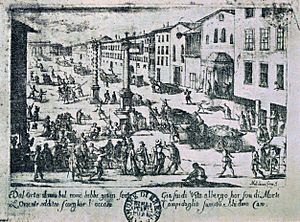1629–1631 Italian plague facts for kids
The Italian Plague of 1629–1631 was a very serious outbreak of a disease called the plague. It is also known as the Great Plague of Milan. This plague was part of a larger series of outbreaks called the second plague pandemic. This pandemic started with the Black Death in 1348 and lasted until the 1700s.
This specific plague mainly affected northern and central Italy. It caused at least 280,000 deaths. Some people think the number might have been as high as one million. This means about 35% of the people living there died. The plague might have also made Italy's economy weaker compared to other countries in Western Europe.
Contents
How the Plague Spread
Where Did the Plague Start?
The plague is believed to have started in Northern France around 1623. It then spread across Europe because soldiers were moving around during the Thirty Years' War. In 1629, soldiers involved in the War of the Mantuan Succession are thought to have brought the disease to Lombardy, a region in Italy.
The Plague Reaches Milan
The disease first spread among soldiers from Venice. By October 1629, it reached Milan. Milan was a very important city for trade in Lombardy. The city tried to stop the disease by setting up a quarantine. This meant limiting who could enter the city and what goods could come in. However, these efforts did not completely stop the disease.
A big outbreak happened in March 1630. This was because health rules were relaxed during the carnival season. Then, a second wave of the plague hit in the spring and summer of 1631. In total, Milan lost about 60,000 people. Before the plague, about 130,000 people lived there.
Plague in Venice and Other Cities
East of Lombardy, the Republic of Venice was also affected in 1630–31. The city of Venice was hit very hard. About 46,000 people died out of a population of 140,000. Some historians believe that this huge loss of life, and its effect on trade, led to Venice losing its power as a major trading and political center.
The city of Bologna, which was part of the Papal States, lost about 15,000 people to the plague. Nearby smaller cities like Modena and Parma were also badly affected. The plague also spread north into Tyrol. This is a mountain region in western Austria and northern Italy.
Later outbreaks of the plague happened in Florence from 1630 to 1633. Other areas like Naples, Rome, and Genoa saw outbreaks in 1656–57.
How Many People Died?
Here is a table showing how many people lived in some cities before the plague and how many died:
| City | Population in 1630 |
Death estimates by 1631 |
Percentage of population lost |
|---|---|---|---|
| Verona | 54,000 | 33,000 | 61% |
| Parma | 30,000 | 15,000 | 50% |
| Milan | 130,000 | 60,000 | 46% |
| Venice | 140,000 | 46,000 | 33% |
| Bologna | 62,000 | 15,000 | 24% |
| Florence | 76,000 | 9,000 | 12% |
A study from 2019 suggested that the plague of 1629–1631 caused slower growth in many cities. It also caused "long-lasting damage to the size of Italian urban populations." This means the plague played a big role in Italy's economy becoming less strong compared to other countries.
The Plague in Books
The 1630 Milan plague is an important part of Alessandro Manzoni's famous novel The Betrothed. This book was written in 1840. Even though it is a made-up story, Manzoni's descriptions of what happened in Milan during the plague are based on real history. He researched many old documents to make his story accurate.
A part of the book that was removed later described the trial and punishment of three people. They were wrongly accused of spreading the plague. This section was later published as a separate pamphlet called Storia della colonna infame (History of the pillar of infamy).
See also
 In Spanish: Plaga italiana (1629-1631) para niños
In Spanish: Plaga italiana (1629-1631) para niños
- Ludovico Settala
- Naples Plague (1656)
- List of epidemics
- Second plague pandemic
- Santa Maria della Salute, a church in Venice built to thank for the city being saved from the plague
- Lazzaretto Vecchio, a small island near Venice used as a cemetery for plague victims
Sources
- Alfani, Guido; Percoco, Marco (2019). "Plague and long-term development: the lasting effects of the 1629–30 epidemic on the Italian cities" (in en). The Economic History Review 72 (4): 1175–1201. doi:10.1111/ehr.12652. ISSN 1468-0289. http://www.ehes.org/EHES_106.pdf.
- Cipolla, Carlo M. (1981). Fighting the Plague in Seventeenth Century Italy. Madison: University of Wisconsin Press. ISBN 0-299-08340-3. https://books.google.com/books?id=Ct_OJYgnKCsC.
- Hays, J. N. (2005). Epidemics and pandemics; their impacts on human history. ABC-CLIO. ISBN 978-1851096589.
- Kohn, George C. (2007). Encyclopedia of Plague and Pestilence: From Ancient Times to the Present (3rd ed.). New York: Facts on File. pp. 200. ISBN 9780816069354. https://archive.org/details/encyclopediaplag00kohn.
- Prinzing, Friedrich (1916). Epidemics Resulting from Wars. Oxford: Clarendon Press. https://archive.org/details/epidemicsresult00westgoog.


